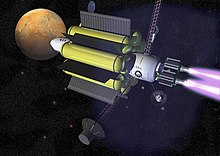
Back محرك دفع بلازما Arabic מנוע פלזמה HE Պլազմային շարժիչ Armenian Motore al plasma Italian 플라스마 추진 엔진 Korean Silnik plazmowy Polish Плазменный ракетный двигатель Russian Плазмовий двигун Ukrainian 電漿推進發動機 Chinese


A plasma propulsion engine is a type of electric propulsion that generates thrust from a quasi-neutral plasma. This is in contrast with ion thruster engines, which generate thrust through extracting an ion current from the plasma source, which is then accelerated to high velocities using grids/anodes. These exist in many forms (see electric propulsion). However, in the scientific literature, the term "plasma thruster" sometimes encompasses thrusters usually designated as "ion engines".[1]
Plasma thrusters do not typically use high voltage grids or anodes/cathodes to accelerate the charged particles in the plasma, but rather use currents and potentials that are generated internally to accelerate the ions, resulting in a lower exhaust velocity given the lack of high accelerating voltages.
This type of thruster has a number of advantages. The lack of high voltage grids of anodes removes a possible limiting element as a result of grid ion erosion. The plasma exhaust is 'quasi-neutral', which means that positive ions and electrons exist in equal number, which allows simple ion-electron recombination in the exhaust to neutralize the exhaust plume, removing the need for an electron gun (hollow cathode). Such a thruster often generates the source plasma using radio frequency or microwave energy, using an external antenna. This fact, combined with the absence of hollow cathodes (which are sensitive to all but noble gases), allows the possibility of using this thruster on a variety of propellants, from argon to carbon dioxide air mixtures to astronaut urine.[2]
Plasma engines are well-suited for interplanetary missions due to their high specific impulse.[3]
Many space agencies developed plasma propulsion systems, including the European Space Agency, Iranian Space Agency and Australian National University, who co-developed a double layer thruster.[4][5]
- ^ Mazouffre, Stéphane (2016-06-01). "Electric propulsion for satellites and spacecraft: established technologies and novel approaches" (PDF). Plasma Sources Science and Technology. 25 (3): 033002. Bibcode:2016PSST...25c3002M. doi:10.1088/0963-0252/25/3/033002. S2CID 41287361.
- ^ "Australian National University develops helicon plasma thruster". Dvice. January 2010. Retrieved 8 June 2012.
- ^ "N.S. company helps build plasma rocket". cbcnews. January 2010. Retrieved 24 July 2012.
- ^ "Plasma engine passes initial test". BBC News. 14 December 2005.
- ^ "Plasma jet engines that could take you from the ground to space". New Scientist. Retrieved 2017-07-29.
© MMXXIII Rich X Search. We shall prevail. All rights reserved. Rich X Search